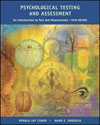Choose the best answer to each question based on material presented in Psychological Testing and Assessment, 5th Edition by Ronald Cohen and Mark Swerdlik.
These questions only sample material from the chapter; there is much more to know than sampled here.
 |
1 |  | 
As originally enacted, Public Law 94-142 mandated that children age 3 and up suspected of having physical or mental disabilities |
|  | A) | be examined by a physician, psychologist, or social worker. |
|  | B) | be evaluated to determine their special education needs. |
|  | C) | be tested to determine the extent of their impairment. |
|  | D) | be advised of their rights with regard to special school placement. |
 |
 |
2 |  | 
In 1986, PL 94-142 was amended |
|  | A) | by a set of amendments known as PL 99-457. |
|  | B) | to extend state obligations downward to birth. |
|  | C) | to include provision for free, appropriate education. |
|  | D) | all of the above. |
 |
 |
3 |  | 
Most checklists and rating scales |
|  | A) | are modeled from the Achenbach. |
|  | B) | are completed by teachers. |
|  | C) | serve as screening tools. |
|  | D) | were originally designed for military use. |
 |
 |
4 |  | 
Which Apgar score, taken at one minute after birth, is indicative of the most serious need for assistance? |
|  | A) | 3 |
|  | B) | 6 |
|  | C) | 9 |
|  | D) | 10 |
 |
 |
5 |  | 
Research by Langlois and her colleagues suggests that attractive infants, as compared to unattractive infants, received from their mothers |
|  | A) | adequate caregiving. |
|  | B) | more positive treatment. |
|  | C) | less handling and attention. |
|  | D) | annuities and endowments. |
 |
 |
6 |  | 
A dual-easel facilitates test administration because |
|  | A) | more than one child may be tested at a time. |
|  | B) | artwork for different test items may be displayed. |
|  | C) | directions are easily accessible to the examiner. |
|  | D) | all of the above. |
 |
 |
7 |  | 
Perhaps the greatest value of preschool tests lies in their ability to |
|  | A) | predict future academic achievement. |
|  | B) | predict future scores on intelligence tests. |
|  | C) | identify children in need of intervention. |
|  | D) | all of the above. |
 |
 |
8 |  | 
A federal mandate exists to identify children with a severe discrepancy between intellectual ability and |
|  | A) | aptitude. |
|  | B) | achievement. |
|  | C) | disability. |
|  | D) | minimum competency. |
 |
 |
9 |  | 
Support of school achievement tests that faithfully reflect what is taught in the schools is reflected in support of |
|  | A) | standardized measurement procedures. |
|  | B) | examinations that require rote memory. |
|  | C) | curriculum-based assessment |
|  | D) | all of the above. |
 |
 |
10 |  | 
In contrast to achievement tests, aptitude tests measure |
|  | A) | innate potential. |
|  | B) | less formal learning experiences. |
|  | C) | knowledge that is hypothetical in nature. |
|  | D) | all of the above. |
 |
 |
11 |  | 
If a version of the Scholastic Aptitude Test (SAT) was developed for use with pre-schoolers, it might most appropriately be called the |
|  | A) | Scholastic Preschool Test (SPT). |
|  | B) | Scholastic Grammar School Test (SGST). |
|  | C) | Prognostic Scholastic Test (PST). |
|  | D) | Scholastic Readiness Test (SRT). |
 |
 |
12 |  | 
Which is NOT an aptitude test? |
|  | A) | The MRT. |
|  | B) | The Seashore Measures of Musical Talents. |
|  | C) | The MCAT. |
|  | D) | The Woodcock-Johnson III. |
 |
 |
13 |  | 
Diagnostic tests may be distinguished from evaluative tests in that diagnostic tests are typically designed to |
|  | A) | pinpoint difficulties. |
|  | B) | make pass/fail types of decisions. |
|  | C) | answer "why" questions. |
|  | D) | measure achievement. |
 |
 |
14 |  | 
In contrast to the sequential learner, the simultaneous learner solves problems best by |
|  | A) | mentally integrating parallel pieces of information. |
|  | B) | mentally arranging information in linear, step-by-step order. |
|  | C) | mentally rehearsing the sequence of possible solutions. |
|  | D) | all the above. |
 |
 |
15 |  | 
Which tool of assessment would be most useful in identifying a worker on an assembly line who is experiencing work-related difficulties? |
|  | A) | The Differential Ability Scales. |
|  | B) | portfolio assessment. |
|  | C) | peer appraisal. |
|  | D) | The What I Like to Do Interest Inventory. |
 |



 2002 McGraw-Hill Higher Education
2002 McGraw-Hill Higher Education